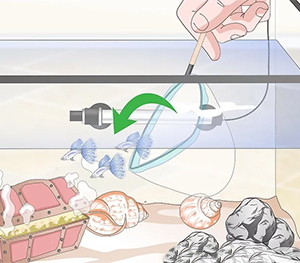Establishing an aquarium with a sump tank can be quite delightful; however, the selection of an appropriate fish tank water pump is of utmost importance.
Whether you are new to fishkeeping or an experienced enthusiast, your objective remains to establish a thriving aquatic habitat. Yet, choosing the ideal aquarium water pump can be challenging.
If you choose one that is too large, there will be a risk of overflow and unnecessary expenses; but if you opt for a small aquarium water pump, it may fail to function as intended.
Therefore, in this article, we aim to assist you in making this crucial decision so that you buy the ideal fish tank water pump and filter.
Aquarium Water Pump – Why Do You Need it?
If you are also one of those wondering, why do you need a fish tank water pump? Well, the answer is pretty much clear!
An aquarium water pump is an essential component for maintaining a healthy aquarium ecosystem. Its main function is to circulate the water and ensure its cleanliness by passing it through a filter.
By keeping the water in motion, the fish tank water pump and filter serve two crucial purposes;
- It promotes oxygenation of the water, enabling fish to breathe comfortably.
- It prevents stagnant areas where waste and debris tend to accumulate.
- The pump acts as an effective cleaner by removing waste and toxins from the aquatic environment, creating a more hospitable habitat for your underwater companions.
Disclosure: This article contains affiliate links. When you follow a link to purchase the products, I sometime earn a commission, at no additional cost to you. Read my full disclosure here.
How to Choose the Right Aquarium Water Pump?
Aquarium Size
The dimensions of your aquarium have a significant impact on the selection of an appropriate fish tank water pump.
For larger tanks, it is important to choose a more powerful pump to effectively circulate all the water. Conversely, smaller tanks require less pumping capacity.
It is important to ensure that the capabilities of the chosen pump. The water pump for small aquarium or large aquarium water pump should align with the volume of your tank to preserve water quality and promote fish well-being.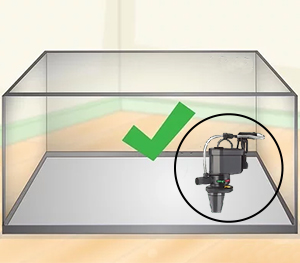
Water Flow and Filtration
Delicate fish and plants require a gentle water flow rate to prevent them from becoming stressed. On the other hand, certain species like bettas prefer calmer waters.
Additionally, different filtration systems such as canister filters or protein skimmers have their own flow rate specifications that need to be considered.
Thus, make sure you choose the appropriate fish tank water pump and filter that is compatible with each other.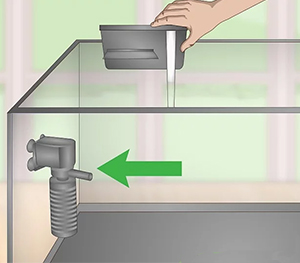
Calculating Flow Rate
Step 1: Calculate the Total Water Volume in Your Tank
Calculate or verify the total water volume in gallons in your aquarium. Your tank can hold this much water when it is filled.
Step 2: Find Your Desired Flow Rate
Select the desired flow rate for your aquarium. A typical range for reef aquariums is 2x to 10x the volume of the entire tank per hour. For most setups, the sweet spot is frequently between 5x and 10x.
Step 3: Calculate the Recommended Flow Rate
Divide the total volume of water in your tank by the selected flow rate. For instance, if you want a 5x flow rate from a 50-gallon tank, you would multiply 50 gallons by 5, which would give you 250 GPH.
Step 4: Take Head Pressure into Account
Keep in mind that once the aquarium water pump is connected to pipes or tubing, head pressure is created, which lowers the flow rate. Depending on the setup you have, this reduction varies, but it’s important to consider this loss when selecting your pump.
Step 5: Adapt based on preference
According to your fish tank water pump and filter preferences, you can choose to activate your pump anywhere between 2 and 10 times more frequently than the total tank turnover per hour. More time to dwell in the sump and lesser noise are two benefits of slower flow rates.
Head Pressure
The resistance water faces as it travels through plumbing elements like pipes and tubes in the aquarium’s system is known as head pressure. The effectiveness and flow rate of the fish tank water pump are significantly impacted by this factor.
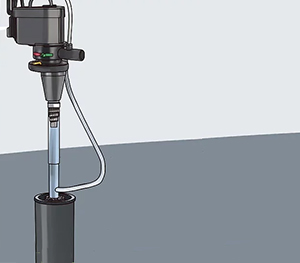
Head pressure calculation method:
You must consider your plumbing system’s vertical lift, distance, and number of turns (elbows) to calculate head pressure. Here is a brief explanation:
- Every 1 ft of vertical rise = 1 ft of head pressure
- Every 90° elbow fitting = 1 ft of head pressure
- Every 45° elbow fitting = 0.5 ft of head pressure
- Every 10ft of flat horizontal distance = 1 ft of head pressure
Breed of Fish
To ensure a peaceful environment for calm-loving fish like goldfish and small tropical species, it is recommended to use a fish tank water pump and filter that circulates the tank water 5-7 times per hour.
Conversely, active swimmers such as koi and large tropical fish thrive in habitats where the water cycles 7-10 times per hour.
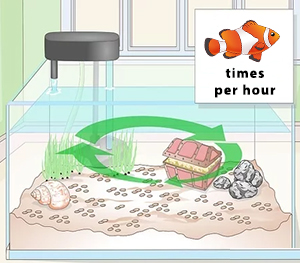
Quantity of Fish
Make sure to match the capacity of your fish tank water pump and filter with the types and number of fish you have.
If your pump and filter system has a lower capacity, consider adjusting your fish population accordingly in order to maintain water quality and minimize stress.
On the flip side, if you have a strong filtration setup, it can support a larger and more diverse fish population, leading to a healthier aquatic environment.
Noise Level
When setting up an aquarium in a shared living space, it is important to consider noise levels and minimize disruptions. Opt for an aquarium water pump or water pump for small aquarium that are specifically designed with noise-dampening features.
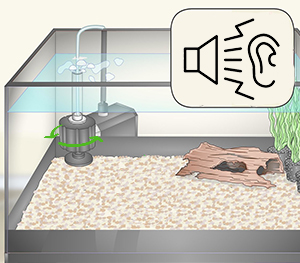
Energy Efficiency
Choosing an energy-efficient large aquarium water pump not only reduces electricity costs but also promotes environmental sustainability.
These high-efficiency aquarium water pumps are specifically designed to provide the required water flow while minimizing power consumption.
By selecting such a fish tank water pump and filter, you can ensure proper circulation in your aquarium without any concerns about excessive energy usage.
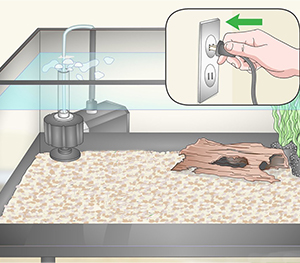
Durability and ease of maintenance
Regular maintenance is necessary to keep your aquarium in top condition. Aquarium water pump for small aquarium with simple designs makes servicing and cleaning easy.
Additionally, choose a fish tank water pump with sturdy building materials to make sure they can endure the demands of the aquatic environment. The inconvenience of repairs and replacements is reduced by a durable and dependable aquarium water pump.
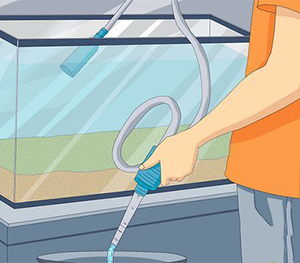
How do you check a water pump?
To effectively assess the functionality of your aquarium’s water pump, it is important to position it strategically above the substrate in order to prevent potential clogs.
Moreover, routinely examine the wire, suction cup, and tubing for any signs of damage or wear. Thoroughly inspect both the water inlet and outlet for possible obstructions that could impede proper water flow.
Additionally, pay close attention to any abnormal sounds like a high-pitched whine as well as peculiar odors resembling steam-like emissions which may signify an urgent need for troubleshooting due to malfunctioning of the fish tank water pump and filter
What to do when the aquarium water pump stops working?
In the case of a malfunctioning aquarium water pump, take immediate action to prevent any harm to the fish.
The first step entails removing any debris and conducting a partial water change, particularly if there are low levels of oxygen.
Next, optimize both the oxygenation and filtration by adjusting the pumps and replacing various filter media components such as sponges, activated carbon, and bioceramic balls.
It is essential to prioritize maintaining high-quality water conditions and adequate oxygen levels to ensure the well-being of your fish.
3 Best Water Pump for Large and Small Aquarium
1. Marineland Maxi-Jet 600
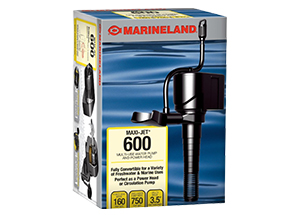
Quick view on Amazon
Available in: Australia, Canada, UK and US
This fish tank water pump provides versatility for both submerged and external applications, along with a sturdy triangular mounting bracket and an omnidirectional ball joint mount that allows for easy adjustment of the flow direction. Although it has a lower GPH (gallons per hour), its unique features make up for this limitation.
| GPH | 149 |
| Best for | 30-40 gallons (113-151 liters) |
2. SunSun JP-024
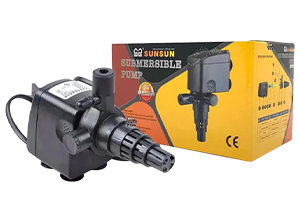
Quick view on Amazon
Available in: Australia, Canada, UK and US
This aquarium water pump provides a powerful water flow, making it suitable for larger aquariums. However, the manual lacks visual aids and clear instructions for assembly and operation.
Additionally, there is an excessive length of hose provided without explanation. The suction cups appear to be insufficiently strong considering the weight of the pump.
Another useful feature is its 360° nozzle which allows for versatile control over water flow despite the unclear instructions provided in the manual.
| GPH | 232 |
| Best for | 55+ gallons (208+ liters) |
3. Aqua Miracle WD800
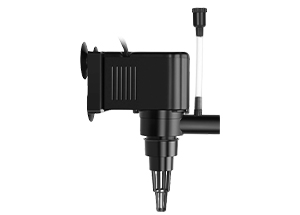
Quick view on Amazon
Available in: Australia, Canada, UK and US
This water pump for small aquarium as well as for large ones, is designed with a durable bracket and strainer, making it easy to use.
However, there are limitations in adjusting the outflow direction as the impeller cover tends to come off easily.
On a positive note, the sliding mounting bracket and sturdy suction cups provide flexibility for installation. Overall, this pump is an excellent option for ensuring strong water circulation in larger tanks.
| GPH | 270 |
| Best for | 55+ gallons (208+ liters) |
Tips and Tricks for Fish Tank Water Pump and Filter
- Strategic Positioning: Position the aquarium water pump at one end of the aquarium and aim it towards the opposite end in order to create a circular water flow pattern.
- Avoid Obstructions: Avoid placing decorations or plants directly in front of the pump as this can disrupt flow and lead to stagnant areas within the aquarium.
- Adjustable Flow: Choose aquarium water pump and filter with adjustable flow settings, as this allows for fine-tuning of water movement according to the specific needs of your fish and plants.
- Supplement with Powerheads: In larger tanks, it may be beneficial to supplement with additional powerheads or large aquarium water pump for circulation.
- Select Powerful Pump: Opt for one slightly more powerful than needed provides flexibility for future additions such as reactors and UV sterilizers. The excess power can easily be adjusted using a valve or controller.
- Utilize In-line Valve and Union Connection: When using AC pumps, it is recommended to incorporate an in-line valve with a true union connection for convenient maintenance and control.
- Explore DC-powered Controllable Pumps: Consider opting for DC aquarium water pumps that provide advantages such as adjustable speed, quieter operation, and improved energy efficiency. While still utilizing a valve and union, they offer more flexibility when adjusting flow rates.
- Optimize Plumbing Diameter: To ensure optimal performance, it is best to match the pump’s inlet and outlet sizes for maximum effectiveness.
Conclusion
In conclusion, selecting the appropriate fish tank water pump and filter for your aquarium is crucial in creating a healthy underwater environment.
Consider factors such as the size of the tank, preferences of the fish, and desired flow rate when choosing a suitable pump.
Additionally, it is essential to prioritize quality and regular maintenance to achieve optimal performance.

